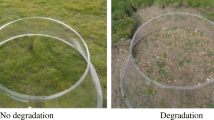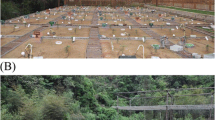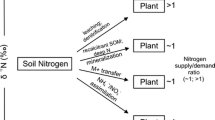Abstract
Background and aims
There is ample experimental evidence for shifts in plant community composition under climate warming. To date, however, the underlying mechanisms driving these compositional shifts remain poorly understood.
Methods
The amount and form of nitrogen (N) available to plants are among the primary factors limiting productivity and plant coexistence in terrestrial ecosystems. We conducted a short-term 15N tracer experiment in a ten-year warming and grazing experiment in an alpine grassland to investigate the effects of warming and grazing on plant uptake of NO3−-N, NH4+-N, and glycine-N. Four dominant plant species (Kobresia humilis, Potentilla anseria, Elymus nutans, Poa annua) were selected. Results We found that 10-years of warming decreased plant uptake of inorganic N by up to 80% in all species. In contrast, warming increased the uptake of organic N in K. humilis, P. anseria, and E. nutans but not in P. annua. Results showed that plant relative biomass increased hyperbolically with the ratio of the plant species total uptake of available N and plant community uptake of available N. And a significant positive correlation between plant species uptake of soil glycine-N and the uptake of total available N.
Conclusions
The stable relative biomass of plant species is largely dependent on organic N uptake by plants. We conclude that plant organic N uptake maintains species dominance under long-term warming.






Similar content being viewed by others
References
Ashton IW, Miller AE, Bowman WD, Suding KN (2010) Niche complementarity due to plasticity in resource use: plant partitioning of chemical N forms. Ecology 91:3252–3260
Brookes P, Landman A, Pruden G, Jenkinson DS (1985) Chloroform fumigation and the release of soil nitrogen: a rapid direct extraction method tomeasure microbial biomass nitrogen in soil. Soil Biol Biochem 17:837–842
Chapin FS, Cleve KV, Tryon PR (1986) Relationship of ion absorption to growth rate in taiga trees. Oecologia 69:238–242
Chapin FS, Matson PA, Mooney HA (2002) Terrestrial decomposition. Springer, New York
Chapin FS, Moilanen L, Kielland K (1993) Preferential use of organic nitrogen for growth by a nonmycorrhizal Arctic sedge. Nature 361:150–153
de Vries FT, Bardgett RD (2012) Plant-microbial linkages and ecosystem nitrogen retention: lessons for sustainable agriculture. Front Ecol Environ 10:425–432
Du YG, Cao GM, Wang Q, Wang CT (2007) Effect of grazing on surface character and soil physical property in alpine meadow. J Mt Sci 25:338–343
Ganeteg U, Ahmad I, Jämtgård S, Aguetoni C, Cambui E, Inselsbacher SH, Schmidt S, Näsholm T (2016) Amino acid transporter mutants of Arabidopsis provides evidence that a non-mycorrhizal plant acquires organic nitrogen from agricultural soil. Plant Cell Environ 10:67–72
Henry H, Jefferies R (2003) Interactions in the uptake of amino acids, ammonium and nitrate ions in the Arctic salt-marsh grass, Puccinellia phryganodes. Plant Cell Environ 26:419–428
Hobbie SE, Chapin FS (1998) The response of tundra plant biomass, aboveground production, nitrogen, and CO2 flux to experimental warming. Ecology 79:1526–1544
Hoffmann AA, Sgrò CM (2011) Climate change and evolutionary adaptation. Nature 470:479–485
Hu YG, Chang XF, Lin XW, Wang YF, Wang SP, Duan JC, Zhang ZH, Yang XX, Luo CY, Xu GP, Zhao XQ (2010) Effects of warming and grazing on N2O fluxes in an alpine meadow ecosystem on the Tibetan plateau. Soil Biol Biochem 42:944–952
Jan MT, Roberts P, Tonheim SK, Jones DL (2009) Protein breakdown represents a major bottleneck in nitrogen cycling in grassland soils. Soil Biol Biochem 41:2272–2282
Jiang LL, Wang SP, Luo CY, Zhu XX, Kardol P, Zhang ZH, Li YM, Wang CS, Wang YF, Jones DL (2016a) Effects of warming and grazing on dissolved organic nitrogen in a Tibetan alpine meadow ecosystem. Soil Tillage Res 158:156–164
Jiang LL, Wang SP, Pang Z, Wang CS, Kardol P, Zhou XQ, Rui YC, Lan ZC, Wang YF, Xu XL (2016b) Grazing modifies inorganic and organic nitrogen uptake by coexisting plant species in alpine grassland. Biol Fertil Soils 52:211–221
Jiang LL, Wang SP, Pang Z, Wang CS, Kardol P, Zhong L, Yu Q, Lan ZC, Wang YF, Xu XL, Kuzyakov Y, Luo CY, Zhang ZH, Jones DL (2017) Effects of grazing on the acquisition of nitrogen by plants and microorganisms in an alpine grassland on the Tibetan plateau. Plant and Soil 416:297–308
Jones DL, Shannon D, Murphy DV, Farrar J (2004) Role of dissolved organic nitrogen (DON) in soil N cycling in grassland soils. Soil Biol Biochem 36:749–756
Jones DL, Healey JR, Willett VB, Farrar JF, Hodge A (2005) Dissolved organic nitrogen uptake by plants - an important N uptake pathway? Soil Biol Biochem 37:413–423
Jump AS, Penuelas J (2005) Running to stand still: adaptation and the response of plants to rapid climate change. Ecol Lett 8:1010–1020
Kuster TM, Wilkinson A, Hill PW, Jones DL, Bardgett RD (2016) Warming alters competition for organic and inorganic nitrogen between co-existing grassland plant species. Plant Soil 406:117–129
Lipson D, Näsholm T (2001) The unexpected versatility of plants: organic nitrogen use and availability in terrestrial ecosystems. Oecologia 128:305–316
Liu C, Song X, Wang L, Wang D, Zhou X, Liu J, Zhao X, Li J, Lin H (2016) Effects of grazing on soil nitrogen spatial heterogeneity depend on herbivore assemblage and pre-grazing plant diversity. J Appl Ecol 53:242–250
Luo Y, Su B, Currie WS, Dukes JS, C Finzi A, Hartwig U, Hungate B, McMurtrie RE, Oren R, Parton WJ, Pataki DE, Shaw MR, Zak DR, Field CB (2004) Progressive nitrogen limitation of ecosystem responses to rising atmospheric carbon dioxide. Bioscience 54:731–739
Maclean IMD, Wilson RJ (2011) Recent ecological responses to climate change support predictions of high extinction risk. Proc Natl Acad Sci 108:12337–12342
McKane RB, Johnson LC, Shaver GR, Nadelhoffer KJ, Rastetter EB, Fry B, Giblin AE, Kielland K, Kwiatkowski BL, Laundre JA, Murray G (2002) Resource-based niches provide a basis for plant species diversity and dominance in arctic tundra. Nature 415:68–71
Miller AE, Bowman WD, Suding KN (2007) Plant uptake of inorganic and organic nitrogen: neighbor identity matters. Ecology 88:1832–1840
Näsholm T, Ekblad A, Nordin A, Giesler R, Högberg M, Högberg P (1998) Boreal forest plants take up organic nitrogen. Nature 392:914–916
Näsholm T, Huss-Danell K, Hogberg P (2000) Uptake of organic nitrogen in the field by four agriculturally important plant species. Ecology 81:1155–1161
Olsen YS, Dausse A, Garbutt A, Ford H, Thomas DN, Jones DL (2011) Cattle grazing drives nitrogen and carbon cycling in a temperate salt marsh. Soil Biol Biochem 43:531–541
Parmesan C (2006) Ecological and evolutionary responses to recent climate change. Annu Rev Ecol Evol Syst 37:637–669
Pritchard HW, Wood JA (1993) Manger influence of temperature on seed germination and the nutritional requirements for embryo growth in Arum maculatum. New Phytol 123:801–809
Raab TK, A Lipson D, Monson RK (1996) Non-mycorrhizal uptake of amino acids by roots of the alpine sedge Kobresia myosuroides: implications for the alpine nitrogen cycle. Oecologia 108:488–494
Reich PB, Hobbie SE, Lee T, S Ellsworth D, West JB, Tilman D, Knops JM, Naeem S, Trost J (2006) Nitrogen limitation constrains sustainability of ecosystem response to CO2. Nature 440:922–925
Rui YC, Wang SP, Xu ZH, Wang YF, Chen CR, Zhou XQ, Kang XM, Lu SB, Hu YG, Lin QY, Luo CY (2011) Warming and grazing affect soil labile carbon and nitrogen pools differently in an alpine meadow of the Qinghai-Tibet plateau in China. J Soils Sediments 11:903–914
Shi Z, Sherry R, Xu X, Hararuk O, Souza L, Jiang L, Xia J, Liang J, Luo Y (2015) Evidence for long-term shift in plant community composition under decadal experimental warming. J Ecol 103:1131–1140
Shi Z, Xu X, Souza L, Wilcox K, Jiang LF, Liang JY, Xia JY, Garcia-Palacios P, Luo YQ (2016) Dual mechanisms regulate ecosystem stability under decade-long warming and hay harvest. Nat Commun 7:11973
Team CW, Pachauri RK, Meyer LA (2014) IPCC, 2014: climate change 2014: synthesis report. Contribution of Working Groups I. II and III to the Fifth Assessment Report of the intergovernmental panel on Climate Change. IPCC, Geneva, Switzerland, p. 151
Unteregelsbacher S, Hafner S, Guggenberger G, Miehe G, Xu X, Liu J, Kuzyakov Y (2012) Response of long-, medium-and short-term processes of the carbon budget to overgrazing-induced crusts in the Tibetan plateau. Biogeochemistry 111:187–201
Vassilevska-Ivanova R, Tcekova Z (2002) Effect of temperature on seed germination and seedling growth of sunflower (Helianthus annuus L). C R Acad Bulg Sci 55:10–67
Walther GR, Post E, Convey P, Menzel A, Parmesan C, C Beebee TJ, Fromentin JM, Hoegh-Guldberg O, Bairlein F (2002) Ecological responses to recent climate change. Nature 416:389–395
Wang SP, Duan JC, Xu GP, Wang Y, Zhang Z, Rui YC, Luo CY, Xu B, Zhu XX, Chang X (2012) Effects of warming and grazing on soil N availability, species composition, and ANPP in an alpine meadow. Ecology 93:2365–2376
Warren CR (2009a) Does nitrogen concentration affect relative uptake rates of nitrate, ammonium, and glycine? J Plant Nutr Soil Sci-Zeitschrift Fur Pflan Und Bod 172:224–229
Warren CR (2009b) Why does temperature affect relative uptake rates of nitrate, ammonium and glycine: a test with Eucalyptus pauciflora. Soil Biol Biochem 41:778–784
Wu HH, Dannenmann M, Fanselow N, Wolf B, Yao ZS, Wu X, Brüggemann N, Zheng XH, Han XG, Dittert K, Butterbach-Bahl K (2011a) Feedback of grazing on gross rates of N mineralization and inorganic N partitioning in steppe soils of Inner Mongolia. Plant Soil 340:127–139
Wu YB, Wu J, Deng YC, Tan HC, Du YG, Gu S, Tang YH, Cui XY (2011b) Comprehensive assessments of root biomass and production in a Kobresia humilis meadow on the Qinghai-Tibetan plateau. Plant Soil 338:497–510
Xu XL, Ouyang H, Kuzyakov Y, Richter A, Wanek W (2006) Significance of organic nitrogen acquisition for dominant plant species in an alpine meadow on the Tibet plateau, China. Plant Soil 285:221–231
Xu XL, Wanek W, Zhou C, Richter A, Song M, Cao G, Ouyang H, Kuzyakov Y (2014) Nutrient limitation of alpine plants: implications from leaf N : P stoichiometry and leaf delta N-15. J Plant Nutr Soil Sci 177:378–387
Zhong L, Du R, Ding K, Kang X, Li FY, Bowatte S, Hoogendoorn CJ, Wang Y, Rui Y, Jiang L (2014) Effects of grazing on N2O production potential and abundance of nitrifying and denitrifying microbial communities in meadow-steppe grassland in northern China. Soil Biol Biochem 69:1–10
Zhou XM (2001) Kobresia meadow of China. Science Press, Beijing
Zhu X, Luo C, Wang S, Zhang Z, Cui S, Bao X, Jiang L, Li Y, Li X, Wang Q (2015) Effects of warming, grazing/cutting and nitrogen fertilization on greenhouse gas fluxes during growing seasons in an alpine meadow on the Tibetan plateau. Agric For Meteorol 214:506–514
Acknowledgements
This work was supported by funding from the Strategic Priority Research Program of Chinese Academy of Sciences (XDA20050104), the National Key Research and Development Program of China (2016YFC0501802), the National Science Foundation of China (31672474, 41731175, 31872994, 31770524), Key program of Tibet Department of Science and Technology, and the NRN-LCEE Sêr Cymru Climate-Smart Grasslands Project.
Author information
Authors and Affiliations
Corresponding authors
Additional information
Responsible Editor: Eric Paterson.
Electronic supplementary material
ESM 1
(DOCX 564 kb)
Rights and permissions
About this article
Cite this article
Jiang, L., Wang, S., Zhe, P. et al. Plant organic N uptake maintains species dominance under long-term warming. Plant Soil 433, 243–255 (2018). https://doi.org/10.1007/s11104-018-3836-x
Received:
Accepted:
Published:
Issue Date:
DOI: https://doi.org/10.1007/s11104-018-3836-x




